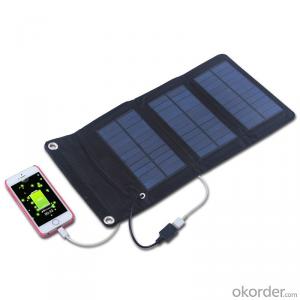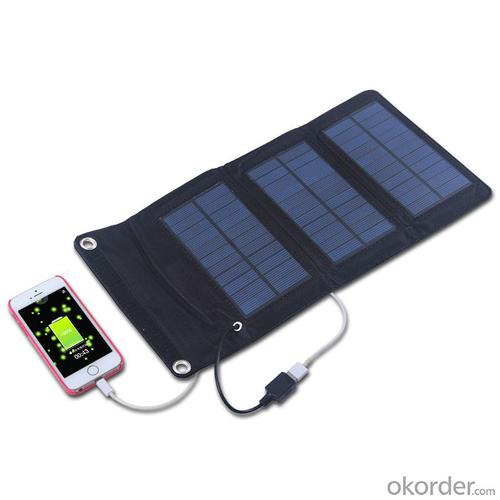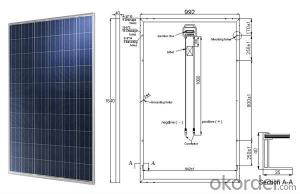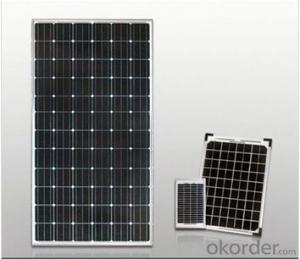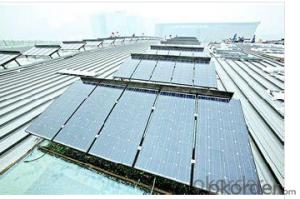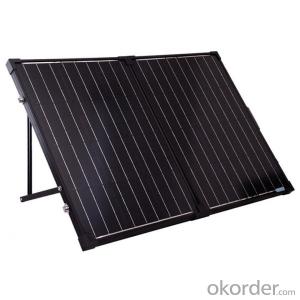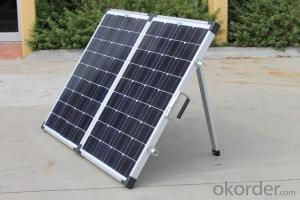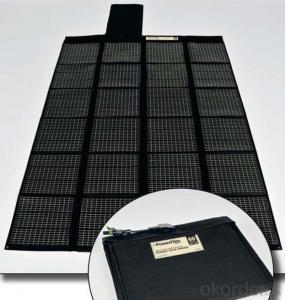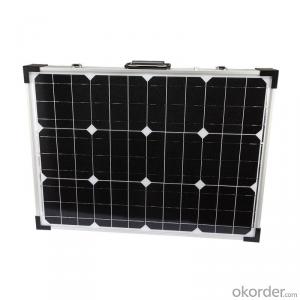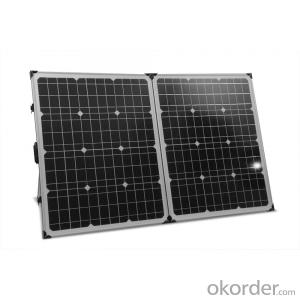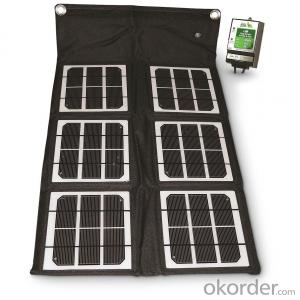20W Folding Solar Panel with Flexible Supporting Legs for Off-Grid Camping
- Loading Port:
- Shanghai
- Payment Terms:
- TT OR LC
- Min Order Qty:
- 1000 watt
- Supply Capability:
- 10000 watt/month
OKorder Service Pledge
OKorder Financial Service
You Might Also Like
Specification
Product Description
Folding module kits are designed to provide portable 12 volt power wherever you need it.PoPwer available from 20W to 240W
Features:
· Padded, moulded carry bag
· Heavy duty carry handle, hinges and clasps Stainless steel telescopic&adjustable legs
· Weatherproof solar charge controller with LED indicator
· 5m cable with heavy duty Anderson connectors between module-regulator & regulator-battery clamps
· All cabled up ready to use
· 2 year warranty
These kits are the ideal solution for 4WD, camping, caravaning, boating and recreational activities whereverpower is required for lights, small TV, camping fridge, pump or other small appliances.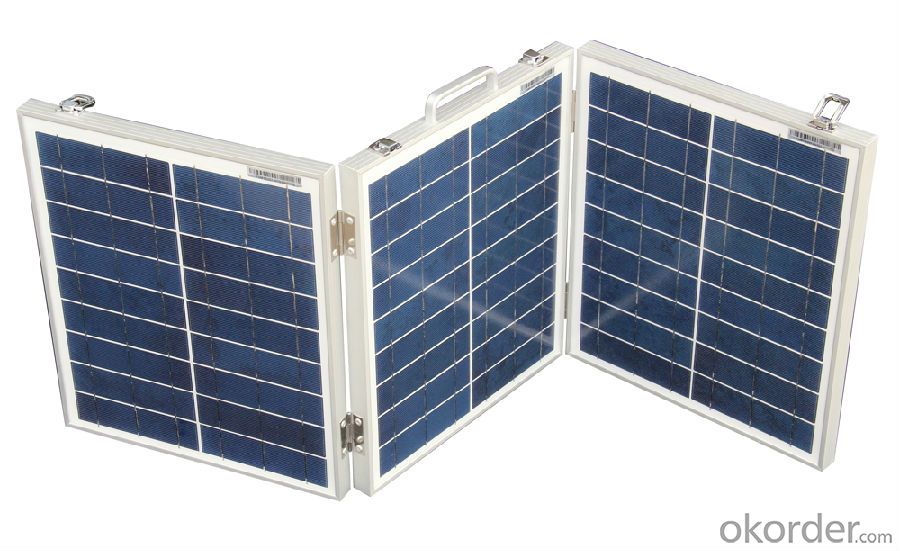
| Nominal Peak Power | 20W | 120W (2 x 60W) | 160W (2 x 80W) | 200W (2 x 100W) |
| Power tolerance | 3% | |||
| Cell type | Monocrystalline/Polycrystalline | |||
| Open circuit voltage (Voc) | 21.6V | |||
| Voltage at maximum power (Vmp) | 17.6V | 17.5V | 17.5V | 17.5V |
| Short circuit current (Isc) | 4.9A | 7.4A | 9.88A | 12.34A |
| Current at maximum power (Imp) | 4.54A | 6.86A | 9.14A | 11.42A |
| Maximum system voltage | 1000VDC | |||
| NOCT (Nominal Operating Cell Temperature) | 45 C +/-2 C | |||
| Operating temperature - module | -40 C to +85 C | |||
| Operating temperature – charge | -35 C to +55 C | |||
| Module folded size (mm) in carry bag | 505x550x60 | 505x825x80 | 505x1005x70 | 670x1005x70 |
| Module open size (mm) | 1014x550x30 | 1014x825x35 | 1014x1005x35 | 1344x1005x35 |
| Module net weight (kg) | 9.2 | 13 | 15.2 | 19 |
| Module gross weight (kg) | 11 | 16 | 19.4 | 23.2 |
| Solar charge controller | PWM 12V 10A; IP65 rated | PWM 12V 20A; IP65 rated | ||
- Q: Can solar panels be used for powering a manufacturing facility?
- Yes, solar panels can be used to power a manufacturing facility. By harnessing the energy from the sun, solar panels can generate electricity that can be used to run various operations in a manufacturing facility, such as powering machinery, lighting, and other equipment. This can help reduce reliance on conventional electricity sources, lower operating costs, and contribute to a more sustainable and environmentally friendly business model.
- Q: 200 watt solar panel generates how much watts of electricity per month?
- I've operated a 25 kilowatt (kw) solar panel system for two years (44 panels, rated at 90 watts each, just about like yours). It averages 0 kilowatt hours (kwh) per day, but clear days get about 60 kwh. My system generates about 3300 kwh per month (we dump directly to grid), worth about $4,000 per year. Payback for my system, which cost $00,000 (after utility rebates and tax credits), is 25 years (the expected lifetime, coincidentally). Under similar conditions, your 200 watt solar panel would average 820 watt-hours per day, or about 25 kwh per month, worth $2.50.
- Q: What is the impact of roof orientation on solar panels' performance?
- The impact of roof orientation on solar panels' performance is significant. The orientation of the roof determines the amount of sunlight the panels receive throughout the day. Ideally, solar panels should be installed on a south-facing roof to maximize their exposure to sunlight. East and west-facing roofs can also work, but they may produce slightly less energy. North-facing roofs are generally not suitable for solar panel installation as they receive the least amount of sunlight. Overall, roof orientation plays a crucial role in determining the efficiency and effectiveness of solar panels.
- Q: what are solar panels?
- Solar okorder /
- Q: How do solar panels affect the roof's lifespan?
- Solar panels can actually extend the lifespan of a roof. They act as a protective layer, shielding the roof from the elements, such as UV rays, rain, and snow. This helps to prevent damage and deterioration, ultimately increasing the roof's longevity.
- Q: Can solar panels be installed on government buildings?
- Yes, solar panels can be installed on government buildings. In fact, many governments around the world have already embraced solar energy and installed photovoltaic systems on their buildings as part of their commitment to renewable energy and sustainability. This helps reduce the carbon footprint of government operations and serves as a positive example for the community.
- Q: I had someone quote me for solar panels on my house but I can't afford it. They were talking about how I have enough room and the perfect location to put many of them and actually get paid for it. I have about a half acre that is tiered and points in the correct direction for them to get pretty much the full day sun. Additionally, I live in so cal where it is sunny most of the year. Does anyone know if solar companies will lease or install them to get the payback? I would be happy to allow them to use the land just to cover my electrical expense and they could have any payback.
- There okorder /... The article below gives some other creative ways to finance a PV system.
- Q: Ok so i have to solar panels to charge a battery however the panels hooked up in series does charge the battery very slowly because series connections only multiplies the voltage but leaves the current the same. Is there a way i can also hook both of them up in parallel at the same time to multiply the current for faster charge? I know i can do this with 4 panels but i dont want to spend extra. So is there a way to hook up 2 solar panels in series and parallel at the same time? Thanks in advace
- Homemade okorder /
- Q: What is the maintenance cost of solar panels?
- The maintenance cost of solar panels is relatively low. Regular cleaning and inspection are recommended to ensure optimal performance, but typically, the cost of maintenance is minimal compared to the savings generated by solar energy.
- Q: Can solar panels be installed on a data center or server room?
- Yes, solar panels can be installed on a data center or server room. By harnessing solar energy, data centers can reduce their reliance on traditional energy sources and decrease their carbon footprint. Installing solar panels not only helps in generating clean and renewable energy but can also lead to long-term cost savings by reducing electricity bills. However, the feasibility and effectiveness of solar panel installation may depend on various factors such as the availability of adequate roof space, local climate conditions, and the energy requirements of the data center.
Send your message to us
20W Folding Solar Panel with Flexible Supporting Legs for Off-Grid Camping
- Loading Port:
- Shanghai
- Payment Terms:
- TT OR LC
- Min Order Qty:
- 1000 watt
- Supply Capability:
- 10000 watt/month
OKorder Service Pledge
OKorder Financial Service
Similar products
Hot products
Hot Searches
Related keywords
